The ability to light a fire under a variety of circumstances is a valuable survival skill and can be the difference between life and death. A fire can be used for boiling water, keeping warm in the worst conditions, signaling for help, cooking and preserving food, providing protection from animals and flying insects, as well as to help to maintain a positive mental attitude (PMA).
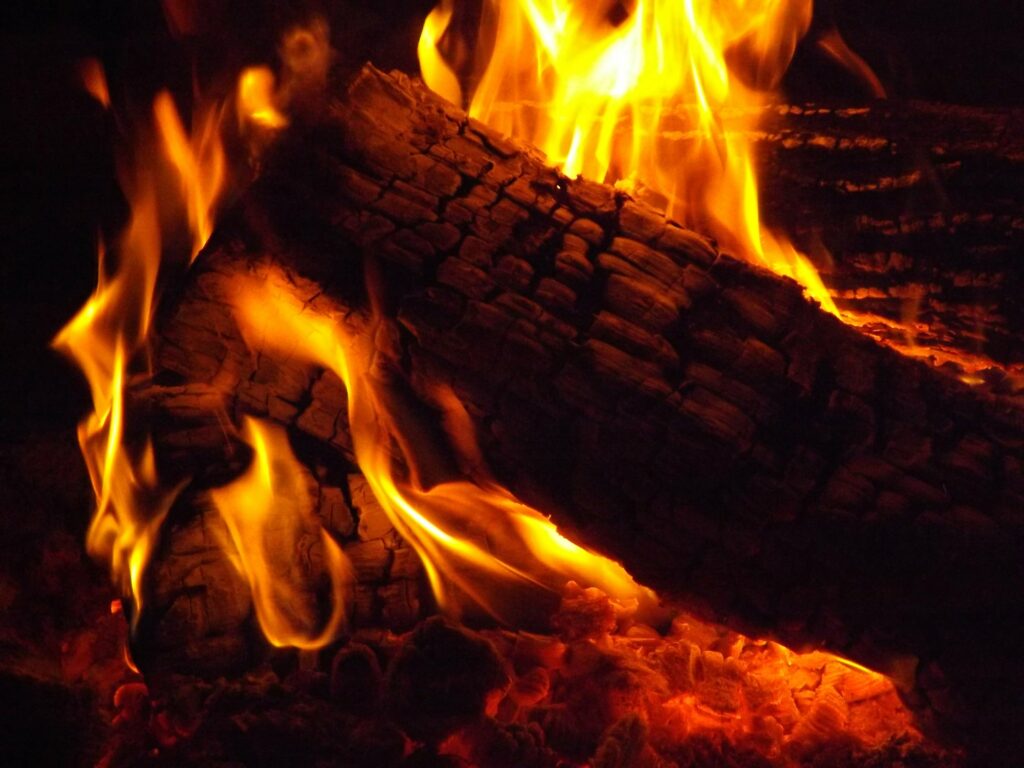
Fire Preparation
A successful fire requires preparation including selecting the appropriate location for the fire, the use of fire making sources, and gathering sufficient quantities of tinder, kindling, and fuel. Here are a few tips for preparing to make a suitable fire to meet your needs:
Location of a Fire
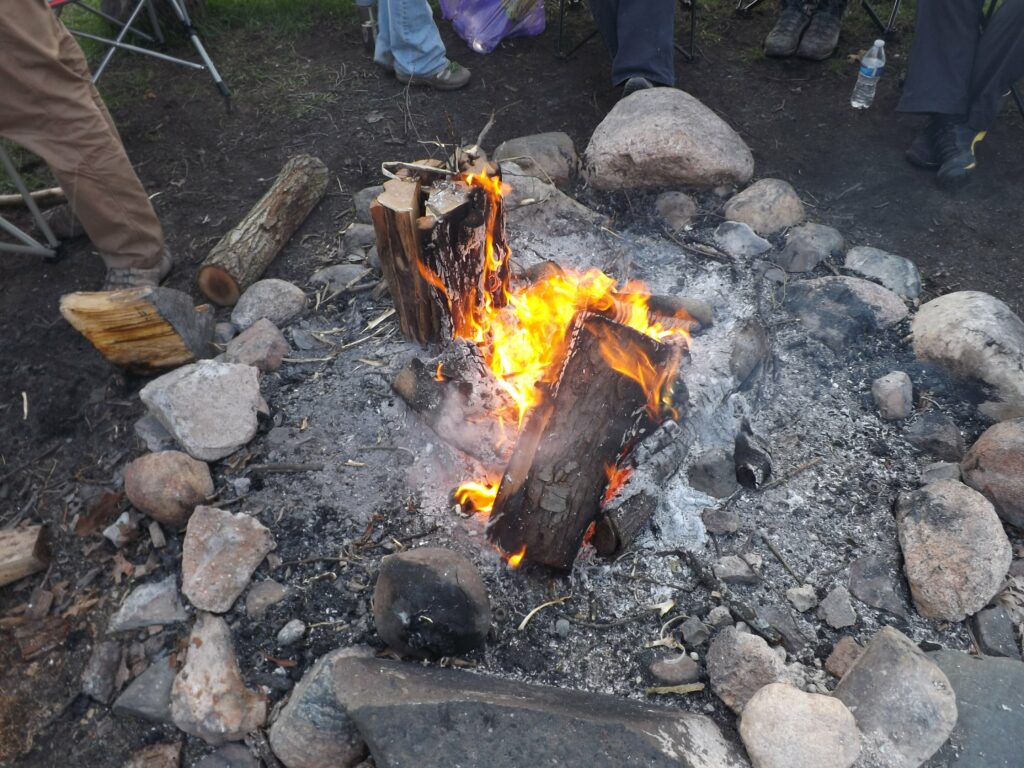
Prior to venturing out into the wilderness, familiarize yourself with the park’s fire regulations and restrictions. Many parks require that, when using a pre-established campsite or backcountry campsite, fires be restricted to designated fire pits or fire rings to prevent forest fires as well as promote “leave no trace” ethics and principles.
In the event a fire pit or fire ring is not available, look for a suitable location that is open and away from trees or ground cover, but also sheltered from high winds. Sandy or gravely soil is preferred within the vicinity of a water supply and additional fuel. Remove all debris including any leaves, twigs, moss, and dry grass to reveal dry earth approximately 5-6ft in diameter. A circle of dry rocks can help contain the fire, but avoid wet, porous, or flaky rocks as they can explode from the heat of the fire. NEVER BUILD A FIRE NEAR DRY OR FLAMMABLE MATERIALS.
- Leave No Trace Principle: Construct a mound fire using soil, sand, and gravel from an already disturbed source. Spread the soil into a circular, flat-topped mound at least 3-5 inches thick to protect the ground below from the heat of the fire. The circumference of the mound should be larger than the size of the fire to allow for spreading coals.
In the event the ground is wet or snow covered, the fire will need to be built on a platform of green logs covered with a layer of earth or stone.
Fire Making Sources
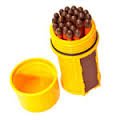
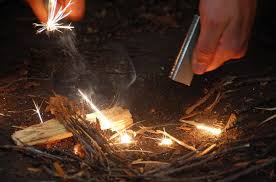

There are basically two types of fire starters; Friction and Spark.
Friction Devices
- Matches: There are a variety of different matches including wooden, “strike anywhere”, and waterproof. Strike anywhere matches are known to be unreliable without the use of a striker pad, however. The best most reliable match is a wooden match carried in a waterproof container. Always use matches sparingly. Lighting a candle with a match will help to minimize the use of matches.
- Primitive Skill Methods: Primitive skill methods such as bow and drill, fire saw, plow board, fire thong, or fire-plunger are difficult to master and require extensive practice to perfect.
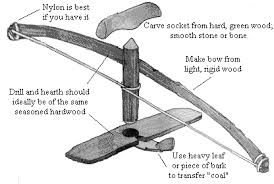
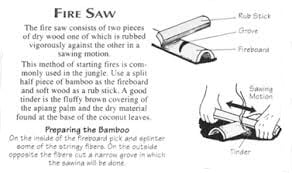
Spark/Heat Devices
Spark/Heat devices are typically used as an alternative or backup system for matches. To capture the best spark, it is advisable to also carry a good ignitable tinder source such as Vaseline soaked cotton balls.
- Lighter (liquid fuel, wick, film, and steel produce spark and flame): Not the most reliable device in high altitude and cold weather environments.
- Flint and steel (to produce a spark)
- Magnesium fire starter/metal match (magnesium bar and steel striker produce spark)
- Chemicals (mixture of two or more chemicals to produce enough heat to ignite tinder)
- Sun and Glass (concentrated sunlight onto tinder): Difficult technique to perfect and requires clear, preferably convex glass, and constant sunlight.
Tinder
Tinder is anything dry that will ignite a spark into a small flame. Though there are many options of tinder that may be used to generate a flame, below is a list of the most common:
- Vaseline soaked cotton ball (best)
- Dry, crushed grass
- Charred cotton cloth
- Fine, dry wood shavings
- Dry cattail fuzz
- Dry, reddish pine needles
- Bird down
- Shaved sticks
- Paper (shredded or rolled)
- Inner bark of cedar or birch tree
- Dried moss or lichen
- Candle
- Oil or gas-soaked cloth
- Birch bark
- Dryer lint
- Dried punk (the completely rotted portion of a dead tree)
- Jute twine (separated)
Kindling
This is where the initial fuel stage begins. Kindling is wood or other dry materials that are used to raise the flames from the tinder. It should be small and burn relatively easily. Small sticks and twigs, finely split wood, or dry grasses twisted into a bunch make ideal kindling.
A fire stick is another form of kindling. To make a fire stick, shave a stick with shallow cuts to feather them. The fire stick will catch light more freely and make fire quickly.
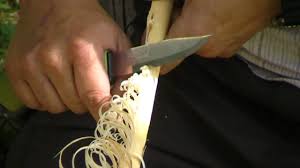
Sustaining Fuel
Sustaining fuel consists of anything that will burn for extended periods of time, but requires high temperatures to continue to burn.
Potential fuel sources:
- Dead wood (standing or recently fallen trees or shrubs). Hardwood for long lasting fires and great heat. Softwood burns fast and may give off sparks.
- Dry peat
- Dried dung
- Split green wood (mix with dry wood for a long lasting fire)
- Animal oil or fat
- Bundles of grass
- Petroleum
- Rubber
- Damp wood (mix with dry wood to produce smoke to deter flies and mosquitoes)
Some fuel sources can be harmful if burned due to the harmful poisonous gasses emitted if burned and may have the potential to explode. Fuel sources to avoid:
- Wood of any contact poisonous plant
- Man-made items (plastics, upholstery, carpet, etc.)
Building the Fire
Select your designated site to build your fire. If the ground is wet or damp, first build a platform of sticks and small logs. The platform will elevate the tinder off of the damp ground and will also help add fuel to the fire as it grows. Gather tinder into a ball (bird’s nest) about the size of your fist and place on the platform.
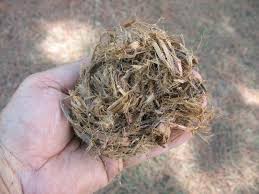
Surround the tinder with a kindling structure. Be sure to allow enough space for oxygen to reach the flame. Build the kindling structure beginning first with thin paper-like materials, add small, thin twigs and build up to larger sticks on the outer-most layer. On a windy day, lean the kindling against a log, similar to a lean-to shelter to provide protection from the wind.
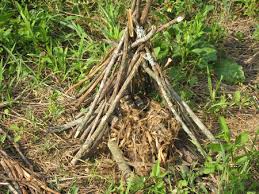

Ignite the tinder using one of your fire making sources. When the kindling produces a flame and begins to burn well, slowly add larger pieces of fuel. Adding fuel too quickly could potentially cut off the flow of air (oxygen) to the flame; which may result in your fire going out. Take your time and if built properly, the fire will gradually increase in intensity through each stage.
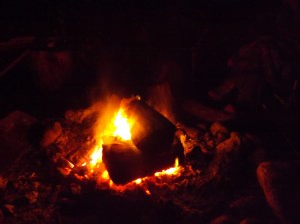
Leave No Trace Principle: Cleanup
Burn all wood until it becomes a white ash. Grind small coals until it becomes a loose powder ash. Thoroughly soak in water to eliminate any traces of heat. Scatter ashes over a large area, away from campsite. Replace any soil where you found it. Scatter any unused wood to keep the area looking as natural as possible.